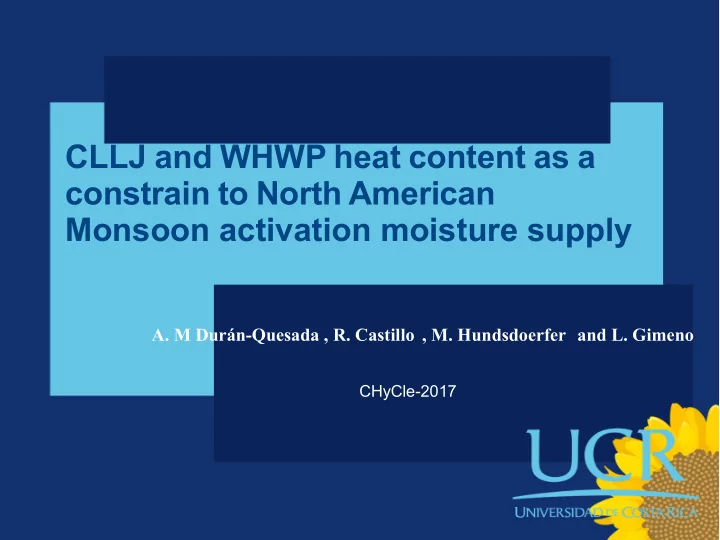

CLLJ and WHWP heat content as a constrain to North American Monsoon activation moisture supply A. M Durán-Quesada , R. Castillo , M. Hundsdoerfer and L. Gimeno CHyCle-2017
Fig 1. Climatological monthly mean of precipitation based on CMAP data for the 1980-1999 period in mm/day and wind vector at 850 hPa from ERA-40 Reanalysis for (a)Winter and (b) Summer. Worth is to notice the largest intensity of precipitation over the tropical belt, from which the ITCZ and the monsoon circulation regions are noticeable as the main large scale features of global precipitation
Variable Dataset Resolution precipitation CHIRPS Daily 0.05° gridded Monthly SST OAFlux 1° gridded Zonal wind ERA Interim 0.75° gridded - MEI index monthly - PDO index monthly Table 1: General information of used data
Analysis domain Fig 2: The NAM core analysis area was defined for the region for which the heaviest rainfall is observed during the active rainy season. Backward trajectories analysis was performed considering the red line polygon as target area of the moisture sources supply. It is worth noticing that the analysis region includes the western portion of the Sierra Madre mountain range and extends over part of the western Sonoran Desert. The Gulf of California has been referred as the main oceanic source of moisture for the NAM development
CLLJ T h e s u m m e r p e a k o f t h e easterly flow d e v e l o p s a north-east ward b r a n c h t h a t enhances the interaction with the moist flow f r o m t h e Caribbean with t h e G u l f o f Mexico and to the Great Plains region Fig 3. Contours of mean zonal wind in m/s (shaded) and wind vectors at 925hPa for the months of a) February, b) July and c) October for the analysis region based on reanalysis data. The reference vector is 10 m/s.
WHWP The WHWP is featured by a seasonal displacement of the warm SST core from a developed Pacific component to a warm water body in the Caribbean Sea Fig 4. Seasonal climatological SST for the analysis region based on ERA-40 Reanalysis monthlydata for the 1980-1999 period. SST larger than 28.5 C is contoured from orange to reddish colors in order to highlight the area comprised by the WHWP as defined by Wang and Enfield, 2001 .
WHWP Components The Pacific component of the WHWP reaches its maximum during late spring, previous to the NAM development, providing warmer conditions south of the Gulf of California. The Caribbean components develops during summer, increasing the release of heat and increasing the height of the boundary layer over the Gulf of Mexico and inner Caribbean Sea. Fig 5: Long term mean annual cycle of the area enclosed by the 28.5 C isotherm for the eastern tropical Pacific (A) and the Caribbean Sea (B) computed from the OAFlux dataset for the 1980-2015 time span. (measured as counts of pixels)
Moisture syupply to the NAM core During late spring, as the NAM activates, local moisture surface exports and evaporation over the Gulf of California represent the main moisture source for the NAM core region. Notice however that the moisture sources analysis for the NAM region is focused on the oceanic sources, since continental moisture supply relies on evapotranspiration which is not resolved with the implemented methodology. As the rainfall over the NAM region increases, the Pacific slope moisture supply decreases and exports from the Gulf of Mexico and the Caribbean Sea become a significant contribution. Fig 6. Moisture sources tracking for the NAM core region based upongthe Lagrangian treajectories diagnostics in mm/day for (A) May and (B) June.
Moisture supply and SST distribution The oceanic moisture sources show a strong correlation with the the structure of the WHWP. Previous to the development of the NAM, the moisture supply from the Gulf of California is linked with the Pacific component of the WHWP, whereas during summer, the moisture exports from the Gulf of Mexico relate to the decrease in the heat in the Caribbean and the warming of the Gulf. Fig 7: Spatial correlation between the overall moisture supply from the Gulf of California (A) and the Gulf of Mexico (B) with SST during May (A) and June (B).
Moisture exports under ENSO During the peak of the NAM, influence of the cold phase on the moisture supply from the Gulf of California is relatively small compared to the mean climatology. The effect of ENSO for the Gulf of Mexico source is larger. The overall contributions from the Gulf of Mexico and the Caribbean Sea increase during July for warm ENSO events Fig 8:Vertical structure of moisture transport for cold (A) and warm (B) ENSO events during July shown in shaded contours (color scale for easterly flow and gray scale for westerly flow). Line contours for composited zonal winds averaged between 10 and 15 N.
Remarks ● The activation of the NAM follows the local moisture surface exports and evaporation over the Gulf of Californiawhich represent the main moisture source for the NAM development. ● The oceanic sources of moisture follow the warmer SSTs distribution in the region and their annual cycle nearly follows the WHWP components. ● Moisture from the Gulf of Mexico and the Caribbean Sea becomes important during July, as the moisture transport is sustained by the northward branch of the CLLJ. ● The overall contributions from the Gulf of Mexico and the Caribbean Sea increase during July for warm ENSO events, as a response to the CLLJ intensifcation.
Thanks Collaboration of M. Hundsdoerfer was supported by a DAAD internship grant.
Recommend
More recommend